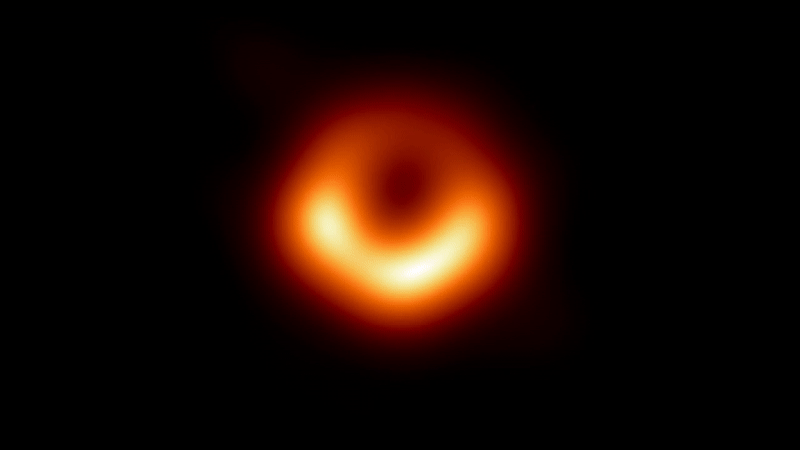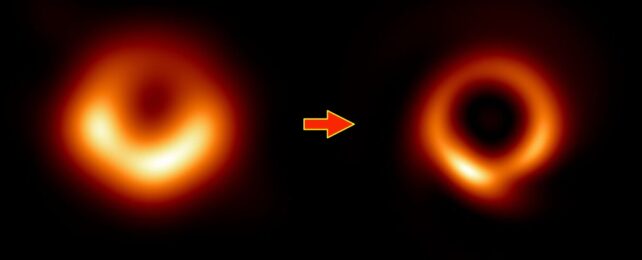This month marks the anniversary of a major achievement in astrophysics.
On 10 April 2019, the Event Horizon Telescope (EHT) collaboration unveiled the first-ever direct image of the shadow of a black hole. Now, scientists have used a new machine learning technique to reprocess the original data to reveal a new, sharper view of the blazing orange material swirling around M87*.
This fresh look gives us a more detailed look at the extreme environment around a black hole, which in turn will improve scientific analyses.
"With our new machine-learning technique, PRIMO, we were able to achieve the maximum resolution of the current array," says astrophysicist Lia Medeiros of the Institute for Advanced Study and the EHT.
"Since we cannot study black holes up close, the detail in an image plays a critical role in our ability to understand its behavior. The width of the ring in the image is now smaller by about a factor of two, which will be a powerful constraint for our theoretical models and tests of gravity."
The galaxy hosting M87*, Messier 87 (or M87), is located 55 million light-years away. It was chosen as the first target for the EHT because that's relatively close, and because, at 6.5 billion times the mass of the Sun, the supermassive black hole at its center is big and active enough that our current technology could resolve it.
Black holes, obviously, can't be seen themselves; but an active supermassive black hole, or one that is actively feeding on matter, has a hot disk and torus of material around it that glows. Even so, imaging M87* was no mean feat.
It took seven radio telescopes around the globe combining their forces to create what is effectively one Earth-sized telescope, and four days' of observing time to collect the data that eventually became the now-familiar image. Then came the data processing, and that was extremely labor-intensive.
However, while groundbreaking and effective, the technique of combining the seven telescopes – known as interferometry – is not perfect. There are gaps in the data, because the telescopes aren't actually one, big, Earth-sized receiver – they're physically spaced apart. So Medeiros and her colleagues developed a machine learning algorithm called principal-component interferometric modeling (PRIMO) to fill in those gaps.

"PRIMO is a new approach to the difficult task of constructing images from EHT observations," explains astronomer Tod Lauer of the National Science Foundation's NOIRLab. "It provides a way to compensate for the missing information about the object being observed, which is required to generate the image that would have been seen using a single gigantic radio telescope the size of the Earth."
PRIMO relies on something called dictionary learning, in which an algorithm is trained by being shown thousands of examples of a thing to learn the rules of how that thing works. The researchers trained PRIMO with over 30,000 simulated images of active black holes so that it could learn how the process works and look for patterns.
Then, PRIMO produced what the researchers say is a highly accurate image of M87*, at the maximum resolution currently possible. It reveals the structure missing from the original image, and is consistent with both the four days' worth of data collected in 2017 – around 5 petabytes' worth – and theoretical predictions.
This new image allowed the team to take more detailed measurements of M87* than was previously possible, and perform more stringent tests of the gravitational regime around it. In future, the algorithm can be applied to other such images, including that of Sagittarius A*, the supermassive black hole at the heart of the Milky Way that was revealed last year.
"The 2019 image was just the beginning," Medeiros says. "If a picture is worth a thousand words, the data underlying that image have many more stories to tell. PRIMO will continue to be a critical tool in extracting such insights."
The research has been published in The Astrophysical Journal Letters.
